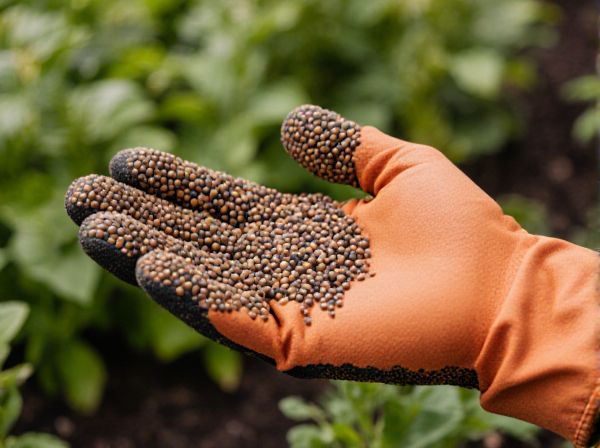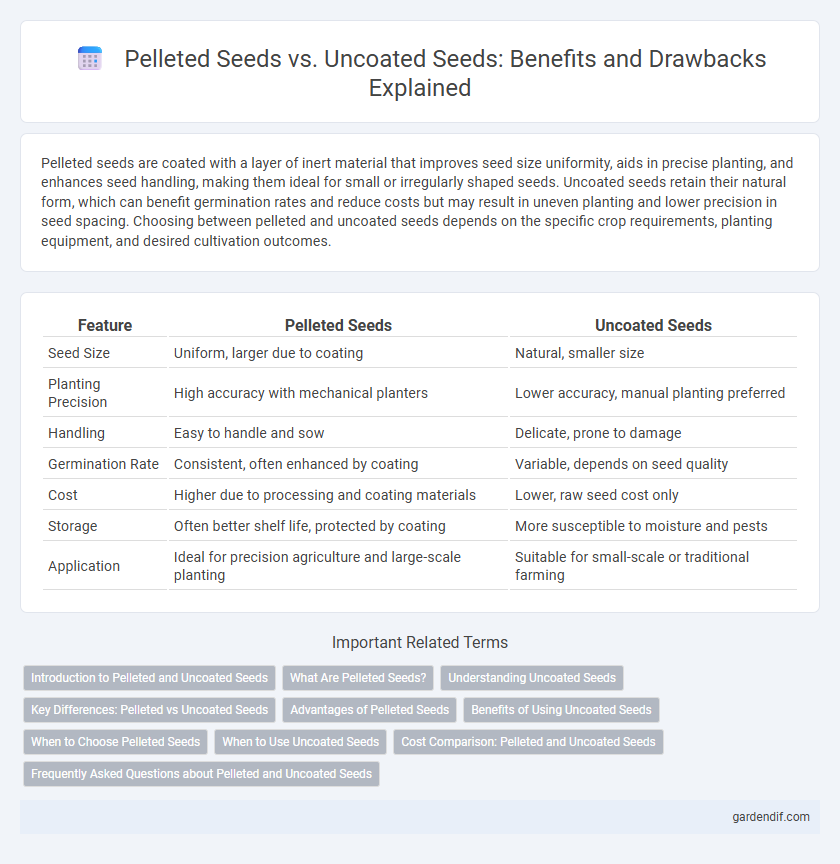
Pelleted seeds vs Uncoated seeds Illustration
Pelleted seeds are coated with a layer of inert material that improves seed size uniformity, aids in precise planting, and enhances seed handling, making them ideal for small or irregularly shaped seeds. Uncoated seeds retain their natural form, which can benefit germination rates and reduce costs but may result in uneven planting and lower precision in seed spacing. Choosing between pelleted and uncoated seeds depends on the specific crop requirements, planting equipment, and desired cultivation outcomes.
Table of Comparison
| Feature | Pelleted Seeds | Uncoated Seeds |
|---|---|---|
| Seed Size | Uniform, larger due to coating | Natural, smaller size |
| Planting Precision | High accuracy with mechanical planters | Lower accuracy, manual planting preferred |
| Handling | Easy to handle and sow | Delicate, prone to damage |
| Germination Rate | Consistent, often enhanced by coating | Variable, depends on seed quality |
| Cost | Higher due to processing and coating materials | Lower, raw seed cost only |
| Storage | Often better shelf life, protected by coating | More susceptible to moisture and pests |
| Application | Ideal for precision agriculture and large-scale planting | Suitable for small-scale or traditional farming |
Introduction to Pelleted and Uncoated Seeds
Pelleted seeds feature a uniform, smooth coating that enhances sowing precision and protects seeds from environmental stress, optimizing germination rates and facilitating mechanized planting. In contrast, uncoated seeds retain their natural form without added layers, offering a more natural germination process but requiring careful handling during planting to ensure even distribution. Selecting between pelleted and uncoated seeds depends on crop type, planting equipment, and desired growth conditions.
What Are Pelleted Seeds?
Pelleted seeds are coated with a layer of inert material to improve seed size, shape, and handling, enhancing precision in mechanical planting. This coating often contains nutrients or growth stimulants that support germination and early seedling development. Unlike uncoated seeds, pelleted seeds provide uniformity and facilitate better soil contact, increasing the chances of successful crop establishment.
Understanding Uncoated Seeds
Uncoated seeds retain their natural outer layer, allowing better water absorption and faster germination compared to pelleted seeds, which are often coated with protective materials to aid handling and planting precision. The absence of a coating means uncoated seeds can be more vulnerable to pests and diseases but generally exhibit higher physiological activity during early growth stages. Understanding uncoated seeds is crucial for farmers aiming for eco-friendly practices and optimized seedling vigor in crop production.
Key Differences: Pelleted vs Uncoated Seeds
Pelleted seeds feature a uniform coating of inert material, enhancing seed size, weight, and flowability, which improves precision during mechanical planting. Uncoated seeds retain their natural shape and weight, leading to variable seed spacing and potentially inconsistent germination rates. The pelleting process also protects seeds from mechanical damage and environmental stress, offering better early-stage growth and emergence compared to uncoated seeds.
Advantages of Pelleted Seeds
Pelleted seeds offer enhanced precision in planting, ensuring uniform seed placement and optimal seed depth, which improves germination rates and crop emergence. Their improved handling characteristics reduce seed loss during sowing and facilitate mechanized planting, increasing operational efficiency. The protective coating also allows for better seed treatment application, enhancing disease resistance and early seedling vigor.
Benefits of Using Uncoated Seeds
Uncoated seeds allow for natural soil contact, promoting better water absorption and faster germination compared to pelleted seeds. They avoid chemical additives or coatings, reducing potential toxicity and environmental impact. Uncoated seeds offer cost-effective planting options, particularly suited for organic farming and sustainable agriculture practices.
When to Choose Pelleted Seeds
Pelleted seeds are ideal when precise planting depth and spacing are crucial, such as in automated sowing or when handling very small seeds that are difficult to sow uniformly. They improve seed flow and ensure consistent emergence by providing a uniform shape and size, making them suitable for high-efficiency commercial agriculture. In contrast, uncoated seeds are better for crops where natural seed morphology does not hinder planting or when cost-saving is a priority.
When to Use Uncoated Seeds
Uncoated seeds are ideal for gardeners looking to closely monitor germination rates and soil conditions without the interference of coatings that may alter water absorption or nutrient delivery. They are preferred in environments where precise seed placement and natural soil interactions are crucial, such as organic farming or experimental plots. Using uncoated seeds allows for greater control over seed treatment and reduces costs associated with pelleting processes.
Cost Comparison: Pelleted and Uncoated Seeds
Pelleted seeds generally incur higher production costs due to additional materials and processing required for coating, leading to increased retail prices compared to uncoated seeds. Despite the initial expense, pelleted seeds often provide improved sowing precision and germination rates, which can offset cost differences in large-scale agricultural operations. Uncoated seeds offer a cost-effective option for growers prioritizing budget constraints but may result in less uniform emergence and higher seed wastage.
Frequently Asked Questions about Pelleted and Uncoated Seeds
Pelleted seeds offer uniform size and shape, improving precision in mechanical planting and reducing seed wastage compared to uncoated seeds. Common questions address the benefits of pelleting for enhancing seed handling, germination rates, and protection from pests versus the natural characteristics and lower cost of uncoated seeds. Understanding the suitability of pelleted seeds for specific crops and soil conditions helps optimize planting efficiency and crop yield.
Pelleted seeds vs Uncoated seeds Infographic

 gardendif.com
gardendif.com